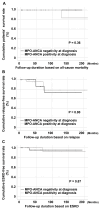Impact of Early MPO-ANCA Positivity on Unique Clinical Features in Korean Patients with EGPA: A Single-Centre Cohort Study
- PMID: 40572776
- PMCID: PMC12194988
- DOI: 10.3390/medicina61061088
Impact of Early MPO-ANCA Positivity on Unique Clinical Features in Korean Patients with EGPA: A Single-Centre Cohort Study
Abstract
Objectives: Previous studies have suggested differences in vasculitic and eosinophilic phenotypes based on anti-neutrophil cytoplasmic antibody (ANCA) positivity in eosinophilic granulomatosis with polyangiitis (EGPA). However, their relevance under the 2022 American College of Rheumatology (ACR)/European Alliance of Associations for Rheumatology (EULAR) classification criteria remains unclear. We aimed to evaluate the clinical features and outcomes of EGPA according to myeloperoxidase (MPO)-ANCA status in a Korean cohort. Methods: We conducted a retrospective cohort study that included 57 patients with EGPA without proteinase 3-ANCA positivity who fulfilled the 2022 ACR/EULAR classification criteria. Patients were classified into MPO-ANCA-positive (n = 25) and MPO-ANCA-negative (n = 32) groups. Clinical manifestations, laboratory findings, and outcomes, including all-cause mortality, relapse, end-stage kidney disease (ESKD), cerebrovascular accident (CVA), and acute coronary syndrome (ACS), were compared between the two groups. Results: MPO-ANCA-positive patients exhibited higher Five-Factor Scores (1.0 [0.0-1.0] vs. 0.0 [0.0-1.0], p = 0.038), lower Short Form 36 Physical Component Summary scores (35.0 [19.7-56.3] vs. 52.5 [43.5-69.7], p = 0.048), and elevated systemic inflammation markers (higher erythrocyte sedimentation rate: 58.0 [16.0-97.5] mm/hr vs. 25.5 [7.0-63.8] mm/hr, p = 0.026). Constitutional symptoms were more frequent among MPO-ANCA-positive patients (n = 14 [56.0%] vs. n = 3 [9.4%], p < 0.001), whereas no significant differences were found in vasculitic or eosinophilic manifestations. Kaplan-Meier analysis revealed no differences in the overall (p = 0.36), relapse-free (p = 0.80), ESKD-free (p = 0.87), CVA-free (p = 0.26), or ACS-free (p = 0.94) survival rates between the two groups. Conclusions: In Korean patients with EGPA classified under the 2022 ACR/EULAR classification criteria, MPO-ANCA positivity, as compared to ANCA-negative status, was associated with a higher disease burden and poorer quality of life but not with distinct vasculitic or eosinophilic manifestations and adverse outcomes.
Keywords: anti-neutrophil cytoplasmic antibody; clinical; feature; myeloperoxidase; vasculitis.
Conflict of interest statement
The authors declare no conflicts of interest.
Figures


Similar articles
-
Clinical value of biomarkers in relation to artery size in eosinophilic granulomatosis with polyangiitis: findings from an inception cohort at a Japanese City Hospital.Clin Rheumatol. 2025 Aug 18. doi: 10.1007/s10067-025-07634-2. Online ahead of print. Clin Rheumatol. 2025. PMID: 40824340
-
Clinical significance of anti-neutrophil cytoplasmic antibody in idiopathic interstitial pneumonia: a retrospective observational study.BMC Pulm Med. 2025 May 29;25(1):271. doi: 10.1186/s12890-025-03736-4. BMC Pulm Med. 2025. PMID: 40442650 Free PMC article.
-
Performance of EMA algorithm, 2022 ACR/EULAR criteria, and EMA-ACR/EULAR algorithm in classifying pediatric ANCA-associated vasculitis: a national cohort study in China.World J Pediatr. 2025 Apr;21(4):372-385. doi: 10.1007/s12519-025-00899-2. Epub 2025 May 10. World J Pediatr. 2025. PMID: 40347428 Free PMC article.
-
The role of tobacco smoking in anti-neutrophil cytoplasmic antibody-associated vasculitis: a systematic review.Clin Exp Rheumatol. 2024 Jul;42(7):1321-1332. doi: 10.55563/clinexprheumatol/nu8ngr. Epub 2024 Jul 4. Clin Exp Rheumatol. 2024. PMID: 38976289
-
Antineutrophil cytoplasmic antibodies in infective endocarditis: a case report and systematic review of the literature.Clin Rheumatol. 2022 Oct;41(10):2949-2960. doi: 10.1007/s10067-022-06240-w. Epub 2022 Jun 23. Clin Rheumatol. 2022. PMID: 35732985 Free PMC article.
Cited by
-
Clinical value of biomarkers in relation to artery size in eosinophilic granulomatosis with polyangiitis: findings from an inception cohort at a Japanese City Hospital.Clin Rheumatol. 2025 Aug 18. doi: 10.1007/s10067-025-07634-2. Online ahead of print. Clin Rheumatol. 2025. PMID: 40824340
References
-
- Jakes R.W., Kwon N., Nordstrom B., Goulding R., Fahrbach K., Tarpey J., Van Dyke M.K. Burden of illness associated with eosinophilic granulomatosis with polyangiitis: A systematic literature review and meta-analysis. Clin. Rheumatol. 2021;40:4829–4836. doi: 10.1007/s10067-021-05783-8. - DOI - PMC - PubMed
-
- Emmi G., Bettiol A., Gelain E., Bajema I.M., Berti A., Burns S., Cid M.C., Cohen Tervaert J.W., Cottin V., Durante E., et al. Evidence-based guideline for the diagnosis and management of eosinophilic granulomatosis with polyangiitis. Nat. Rev. Rheumatol. 2023;19:378–393. doi: 10.1038/s41584-023-00958-w. - DOI - PubMed
-
- Comarmond C., Pagnoux C., Khellaf M., Cordier J.F., Hamidou M., Viallard J.F., Maurier F., Jouneau S., Bienvenu B., Puéchal X., et al. Eosinophilic granulomatosis with polyangiitis (churg-strauss): Clinical characteristics and long-term followup of the 383 patients enrolled in the french vasculitis study group cohort. Arthritis Rheum. 2013;65:270–281. doi: 10.1002/art.37721. - DOI - PubMed
-
- Sinico R.A., Di Toma L., Maggiore U., Bottero P., Radice A., Tosoni C., Grasselli C., Pavone L., Gregorini G., Monti S., et al. Prevalence and clinical significance of antineutrophil cytoplasmic antibodies in churg-strauss syndrome. Arthritis Rheum. 2005;52:2926–2935. doi: 10.1002/art.21250. - DOI - PubMed
MeSH terms
Substances
Grants and funding
LinkOut - more resources
Full Text Sources
Medical
Research Materials
Miscellaneous

